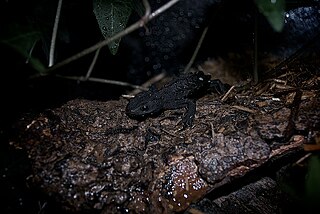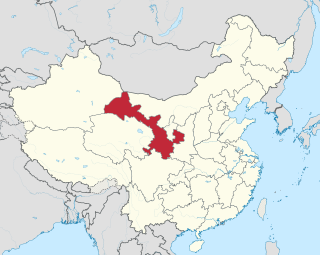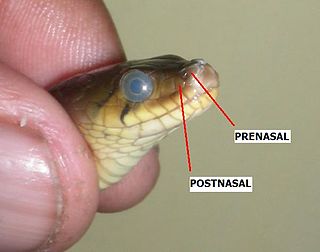
The golden gecko is a species of gecko, a lizard in the family Gekkonidae. The species is native to Vietnam.

The tokay gecko is a nocturnal arboreal gecko in the genus Gekko, the true geckos. It is native to Asia and some Pacific Islands.

Tianshui is the second-largest city in Gansu Province, China. Its population is approximately 3.5 million. The city and its surroundings have played an important role in the early history of China, as still visible in the form of historic sites.

The Chinese fire belly newt is a small black newt, with bright-orange aposematic coloration on their ventral sides. C. orientalis is commonly seen in pet stores, where it is frequently confused with the Japanese fire belly newt due to similarities in size and coloration. C. orientalis typically exhibits smoother skin and a rounder tail than C. pyrrhogaster, and has less obvious parotoid glands.

The Gansu shrew is a red-toothed shrew found only in a small part of Gansu province and other adjacent areas of China. With its very limited range, it is sensitive to habitat loss and is listed as a "vulnerable species" in the Chinese Red List, while the IUCN lists it as being "data deficient"

Gekko smithii, commonly known as Smith's green-eyed gecko or the large forest gecko, is a species of gecko in the family Gekkonidae. It is found in mainland Southeast Asia and Indonesia.

Sphenomorphus indicus is a species of skink.

Longnan is a prefecture-level city in the southeast of Gansu province in China. It borders Sichuan on its south and Shaanxi on its east.
The Ganzu vole, Eva's red-backed vole, Eva's vole, Gansu vole, or Taozhou vole is a species of rodent in the family Cricetidae. It is found in mountain forests in China. The IUCN has assessed it as being of "least concern".
The Chinese scrub vole, or Irene's mountain vole, is a species of rodent in the family Cricetidae. It is endemic to mountainous parts of southern China and is very similar to the Sikkim mountain vole in appearance. The International Union for Conservation of Nature has assessed its conservation status as being of "least concern".
The Duke of Bedford's vole is a species of rodent in the family Cricetidae. It is found only in mountainous parts of central China. It is a rare species and the International Union for Conservation of Nature has assessed its conservation status as being "vulnerable".

The Wenxian knobby newt or Wenxian knobby salamander is a species of salamander in the family Salamandridae. It is endemic to central China. Its type locality is Wen County in Gansu, or in Chinese: 文县; pinyin: Wénxiàn, hence the name.

The pygmy salamander is a species of salamander in the family Plethodontidae. It is endemic to the United States in the southern Appalachians in North Carolina and Tennessee.
Nanorana taihangnica, or the Taihangshan swelled-vented frog, is a species of frog in the Dicroglossidae family. It is endemic to central China. Its type locality is on the Taihang Mountains, within the Jiyuan city in Henan province of central China. It is now also reported from Qin, Funiu and Zhongtiao Mountains, with its distribution also including Gansu and Shaanxi provinces. There is substantial differentiation among lineages from different mountains.
Large odorous frog, Odorrana graminea, is a species of frog in the family Ranidae. It is found in southern China (from southern Anhui and northern Zhejiang west to extreme southern Gansu, southeastern Sichuan, and southern Yunnan to the border of Vietnam, Laos and Myanmar, although it has not yet been recorded in the latter two countries. Its type locality is the Wuzhi Mountain in Hainan. Until the revision of "Rana livida" in 2003, this frog was considered a synonym of Odorrana livida. The species occurs near fast-flowing rivers and streams in montane tropical forests.
The Chinese jumping mouse is a species of rodent in the family Dipodidae. It is monotypic within the genus Eozapus. It is endemic to China where its natural habitat is temperate forests, steppes and meadows in mountainous regions. It is tolerant of some degree of habitat destruction, and the International Union for Conservation of Nature has assessed its conservation status as being of "least concern".
Liushusaurus is an extinct genus of lizard described by Susan E. Evans and Yuan Wang in 2010. The genus has a single species, Liushusaurus acanthocaudata, and is known from eight fossils, several of which preserve soft tissue detail. The specimens were found in the Lower Cretaceous aged Yixian Formation of Northeast China. Liushusaurus is one of eight lizards that are known and have been named from the Yixian Formation, part of the diverse Jehol Biota ecosystem.

Gekko monarchus, also called the spotted house gecko, is a species of gecko found in the Malay Peninsula, some smaller Malaysian islands, Borneo, the Philippines, many Indonesian islands including Sumatra, Java, Sulawesi, and New Guinea.



















